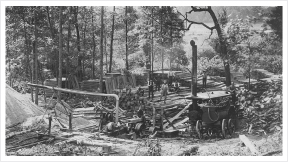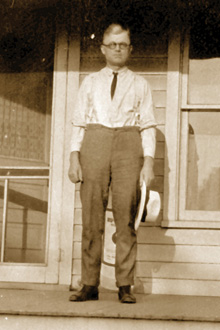 |
| |
| |
 |
| A crew of about 29 ran the operations at the North Cochran plant in the 1930. |
| |
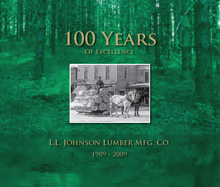 |
| Download our vintage photo book |
| |
 |
| Circa 1915: Logging Camp Site |
| |
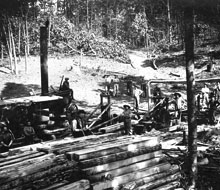 |
Circa 1915: Woodland
Steam Powered Sawmill. |
| |
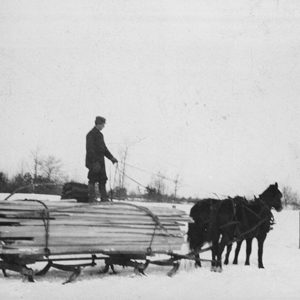 |
Circa 1915: Horse sled hauling lumber
off farm woodland. |
| |
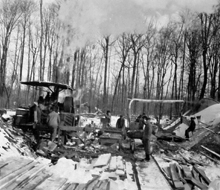 |
| Circa 1915: Steam powered Portable Sawmill |
|
IT ALL STARTED WITH RAILROAD TIES & CROSSING PLANKS |
In 1909, just a few miles south of Albion, MI, Laurin Lewis Johson set up a sawmill surrounded by plentiful stands of hardwood timber. L.L., as he was called, cleared this site to cut railroad ties, switching ties, and crossing planks for the booming railroad buisiness in Michigan.
By 1922, after the railroad grew beyond the state, L.L. decided to move his operation to Eaton County and established a permanent circular sawmill and planing mill in Charlotte. Now his operation was closer to the growing automobile businesses in Lansing and Flint, which needed lumber for making cars and trucks. During the late 1920s, however, when steel started to replace wood in cars, L.L. looked to the furniture factories of Grand Rapids as a new market for the lumber he was harvesting.
At the same time, his son Darrel graduated from Albion College and worked for a lumber company in Ohio, gaining valuable experience about the business. By 1928, Darrel returned to Michigan to become a partner with his dad. Together they planned how to grow their business and meet the growing demand of lumber from the furniture factories in Grand Rapids. Bleached maple furniture was all the rage and fueled the booming furniture business of the state. To meet this growing market for maple, L.L. and Darrel replaced their original circular saw with a new band sawmill, built dry kilns, and established warehouse facilities.
Fittingly, the business was incorporated in 1966 as the L.L. Johnson Lumber Manufacturing Company, honoring its founder. Now in its fourth generation, the company continues to grow, but in different directions. The mill no longer saws whole logs, but still machines rough lumber.
The lumber L.L Johnson sells today comes from resources throughout the world as kiln-dried graded lumber. Also the company operates two retail outlets (Charlotte, MI and South Bend, IN), supplying woodworking hobbyists and professionals throughout the country with fine tools and accessories.
After more than 100 years, the business L.L. Johnson started in that plentiful stand of timber continues to grow, building that legacy of hard work, honesty, and devotion to servicing our customers and delivering a quality product. |
| |
| 1909 LUMBER CAMP LIFE |
| When the fiddle had stopped singing Laura called out softly, “What are days of auld lang syne, Pa?”
“They are the days of a long time ago, Laura,” Pa said. “Go to sleep, now.”
‘Little House in the Big Woods’ by Laura Ingalls Wilder was an alluring read for many young children in the 60s and 70s. It gave them a glimpse of what life was like for their great-grandparents.
Having a great-grandfather, L.L. Johnson, who was a lumberjack in the early 1900s makes Michigan’s lumber history come to life for our family. Beginning in 1909, our great-grandfather, L.L, and his men led a nomadic lifestyle harvesting lumber. The logging crew would move right to the woodlot of a farm, drill a well, and set up shanties as their living quarters. L.L. would often purchase the farms, fix and repair them while harvesting the timber. Then sell the farms as they moved on to the next woodlot, never letting too much sawdust gather at their feet.
The image of the lumberjack was often romanticized in illustrations and stories such as the tales of Paul Bunyan. But the actual life of a logger was very dangerous, filled with long, backbreaking days. Logging was done in the dead of winter when farmer labor was available. Trees were felled with muscle-powered crosscut saws. Lumber and logs were hauled about on hulking, horse-drawn sleds.
The day for a lumberjack began before dawn. Breakfast was served while it was still dark so the men could eat and be out in the woods ready to work at the first crack of daylight. Lunch and dinner would be brought out into the woods where the men were working. Lumberjacks would work until dark, then walk back to camp for supper. It was not unusual for breakfast to be served at four or five a.m., lunch at nine, dinner at two-thirty, and supper at eight, with lights out at nine.
The camp cook and his helper, often referred to as ‘cookee’, were vital members of a lumber camp crew. Whether or not our great-grandpa and other camp bosses were able to hire a full crew was largely dependent on the cooking. If it wasn’t tasty enough or plentiful enough, lumberjacks were known to walk off the job.
The cook and cookee worked 16 to 17 hour days, seven days a week. Their day would begin no later than 3 a.m. grinding coffee beans. It would take up to an hour to grind enough coffee for 25 to 30 men.
Breakfast might consist of fried potatoes, beans, pancakes with molasses syrup or gravy, hot biscuits, coffee, pork sausages and other meats. Lunch was eaten in the woods. A campfire would be set to boil tea and food would be placed around the fire for the men to dish up and eat quickly before it had a chance to freeze on their tin plates.
Supper was more substantial with pork and beans, potatoes, meat and gravy. For dessert there were usually dried fruit pies -- raisin, and dried apple. “Vinegar pie” was often served.
Many is the impression that lumberjacks were rough, rowdy, loud, and burly, up until all hours of the night drinking, singing, and storytelling. But that was only after the logging season was done in the spring. Several historical entries report of strict camp rules such as no talking while eating, and early lights out. Good food, long grueling days, strict rules of conduct -- that was life in a logging camp in 1909. |
|
| SIX UNITS BATTLE LUMBER STORE FIRE |
| Hundreds of onlookers gathered around the burning building
as flames shot into the air. |
 |
SPECIAL NOTE: The following article appeared in the April 15, 1989 edition of the South Bend Tribune.
TERRENCE BLAND staff writer
SOUTH BEND -- Six area fire departments Friday night battled a fire that destroyed the showroom of Johnson’s Workbench, 51315 U.S. 33 N., about one-quarter mile north of Auten Road in Clay Twp.
Clay Twp. Fire Chief Robert Lindzy estimated loss of the showroom would total at least $100,000.
Lindzy said firefighters were likely to remain at the scene until early this morning.
The fire first was seen about 8:45 p.m. Friday by a man who stopped at Morris Video, just south of Johnson’s, and told an employee there to call firefighters. Tony Long, who works at the video store, said he walked outside and saw flames creeping through the peak of the showroom roof. Long said after he called emergency dispatchers, “it only took 15 minutes and it was up.”
Bill Edmondson, who had just rented some videotapes from Morris, said, “It was like a string of firecrackers” when heavy flames began igniting cans of wood stain and paint inside the showroom. Long said he “didn’t see anyone around the building at all when he walked outside to investigate the fire.
The showroom of the specialty lumber store was engulfed in flames when Clay Twp. firefighters arrived at the scene. Additional assistance was called for immediately, and firefighters arrived from German, Portage, and Harris townships in St. Joseph County and Howard and Niles townships in Berrien County. The store is just south of the Michigan state line. Manpower also was brought in from the University of Notre Dame Fire Department. A cause of the fire had not been determined by early this morning.
Lindzy indicated the fire probably had been smoldering for some time before it was discovered which he said was unusual since the showroom faces a heavily traveled highway. Lindzy said when firefighters arrived, they concentrated their efforts on saving the storage portion of the building, directly west of, or behind, the showroom. Firefighters were able to attack the fire from the west and push it out away from the storage room which, if ignited, would have caused even more extensive damage, according to Lindzy.
“There’s a fire wall there, but they actually stopped (the fire) before it got to the fire wall,” Lindzy said, referring to the protective barrier that separates the show room from the storage room. The blaze was brought under control in about 45 minutes, Lindzy said. Tired firefighters continued to pour water on smoldering timbers late into the night.
Clay Twp. Lt. Jim Hummell said the store is a specialty store that sells stains, woodworking material and fine lumber for craftsmen. Hummell said flames were shooting out the roof of a pole-type structure when he arrived. Hummell, who was operating a large semi-truck tanker at the scene, estimated 30,000 gallons of water were poured on the fire by about 9:30 p.m., and much more water was expected to be used.
“That was our main concern, water supply,” Hummell said.
Hundreds of onlookers gathered around the burning building as flames shot into the air, tossing burning embers and thick smoke high into the evening sky. County and state police blocked traffic at U.S. 33 and Auten and at intersecting roads north as hundreds of feet of hose were strewn across the highway. Tanker trucks drove to and from the scene frequently in an effort to keep the water supply adequate.
“They’ve done a helluva job,” Lindzy said of the more than 40 firefighters battling the blaze.
About 8:30 p.m. Friday, Penn North and Penn South fire units in northeastern St. Joseph County were dispatched to assist Osceola firefighters battling a fire in a two-story house at Vistula and Beech roads. Information about that fire was not available early today. Officials said there were no problems fighting both fires at the same time because several adjacent fire departments provided mutual aid to the Clay and Osceola fire departments.n
|
 |
| Johnson's Workbench Store in South Bend IN today. |
|
| OUR 100 YEAR TIMELINE |
| 1909 |
| Thirty-four year old Farmer Laurin Lewis Johnson and his wife Zae D. began a portable sawmill operation using money Zae had saved from her teaching job. For more than 10 years, L.L. lived a nomadic lifestyle, during the late fall and winter months, moving his operation from woodlot to woodlot, initially producing a half-million feet of hardwood lumber each year for oaken railroad ties and crossing planks needed for the new railroad lines being built across Michigan. |
| 1922 |
| L.L. built a stationery sawmill and planing mill on N. Washington Street in Charlotte, MI to better service the growing auto industry's demand for hardwood to make car and truck bodies. By this time, the business had grown to producing over a million feet of lumber annually. |
| 1924 |
| As the horseless carriage put old fashioned horse power out to pasture, L.L.'s lumber mill became a year-round business, using trucks to haul logs from surrounding woodlots to the mill, then shipping finished lumber out by rail and truck. |
| 1928 |
| L.L. set up partnership with his son Darrel. Darrel saw the inevitable decline in the auto industry's need for lumber and decided that furniture was the key. Soon, truckloads of quality, clear-grained maple were rumbling out of the sawmill three times a week, bound for furniture factories in Grand Rapids. |
| 1929 |
| During the long economic drought of the Great Depression, it was not unusual for the company to take goods instead of cash for its lumber. Several REO trucks were added to the company fleet as part of this Depression-era bartering. |
| 1941 |
| The Company's first (of six) dry kiln was built to speed the lumber drying process. In the early days, seasoning hardwood was a long and laborious process. Once milled, lumber would be stacked and left to season in open air. Later, the lumber was then stacked in heated work areas for another lengthy time period to complete the process. |
| 1950s |
| The third generation of Johnson entered the business - Darrel's three sons, Dick (1954), Bob (1956) and Ted (1958). |
| 1960s |
| The 1960's saw the biggest expansion in the company's history. New machines were added to mechanize the cutting, edging, resawing, and trimming of logs. |
| 1962 |
| Johnson Lumber was a pioneer in the use of a guideline light allowing the operator to see precisely where the log is to be cut, substantially reducing wood waste.
This same year, a 40-foot revolving round table for sorting lumber was designed and built, using a tenth of the power needed for the conventional green chains found in most mills |
| 1966 |
| The Company was formally incorporated as the L.L. Johnson Lumber Mfg. Co. |
| 1970 |
A computerized log carriage was installed in the sawmill. An operator can, through computer commands, tell the carriage exactly where the cut should be made. A more uniform product was the result.
The same year, the company began issuing catalogs for schools and woodworking shops as an outlet for cabinet-making supplies |
| 1975 |
| The Company's first retail outlet, Johnson's Workbench, was established in Charlotte MI. A second store was added in South Bend IN in 1980, with a third in Grand Rapids MI in 1997. |
| 1977 |
| Fourth generation Johnson's began entering the business with Dick's son Mark, and then Bob's son Steve two years later in 1979. Ted's son Mike joined the Company in 1981. Dick's youngest son, Tim joined in 1984.
Ted and Mark collaborated to undertake a major renovation of the main plant that included a new roof, raised pipe system, new sprinkler system, new wiring, new blower system, and a catwalk for plant tours. |
| 1978 |
| The business offices, and later the Workbench stores were computerized for tracking inventories and pricing. Steve Johnson was instrumental in the installation and programing of the computers. |
| 1985 |
| Dick and Ted became the owners of the Company. |
| 1991 |
| The Company organized their first Wood Expo, featuring Scott Phillips, of The American Woodshop television show on PBS. The yearly event expanded to our South Bend IN (Wood Showcase), and Grand Rapids MI (Wood Fair) locations. |
| 1997 |
| A company website was developed (theworkbench.com) which helped to double the company's earnings. The company began serving customers worldwide. |
| 2000 |
| Two new warehouses were built to increase the company's capacity for lumber and plywood storage. |
| 2004 |
| The Company became ISPM 15 certified, expanding their service offerings to include heat treating for companies using wood crates and containers for international shipments. |
| 2006 |
| Johnson's Workbench became a Rockler Partner Affiliate, offering an extensive Specialty Hardware product line. |
| 2008 |
| Mark and Tim bought out Dick and Ted to become the new owners. |
| 2009 |
| Wood & Wood Products magazine named L.L. Johnson Lumber Mfg Co. as one of the Top 100 Fastest Growing Wood Products Companies nationally. |
| 2010 |
| Johnson's Workbench, Grand Rapids MI branch, closed its doors on Burton Street and opened new doors to a 'special order' pick-up site just down the road...located on 29th Street in the building where Woodsource use to be located. |
| 2013 |
| A new, robust company website was launched (theworkbench.com) which greatly increased the depth of product, service, and industry information available to our woodworking customers. |
| |
CHARLOTTE MAN DRIVES TRUCK A MILLION MILES IN 40 YEARS:
NO ACCIDENTS |
|
| The following article appeared in the October 3, 1963 edition of the Charlotte Republican Tribune. |
| Two unusual achievements can be credited to Murray Diamond -- faithful service to the same employer for 41 years and more than 1,000,000 miles of truck driving without an accident.
But 64-year-old Diamond, a native of Charlotte, is a rather retiring sort of person and rather reluctant to talk about the achievements. His employers at the L.L. Johnson Lumber Co., however, are proud of his record.
Born in Charlotte, the son of the late Fred and Nellie (Midland) Diamond, Murray secured his education in the Bush school and Charlotte public schools. At an early age, however, he began working, right at the outset, in the lumber business.
When he was only 16 years old Mr. Diamond began driving a team of horses, drawing logs for the Ezra Huber sawmill at Center Eaton. The fall and early winter of 1922 found him doing the same for Bert Lee, bringing logs into Charlotte. But when a horse fell and broke a leg, Murray found himself out of work.
That was the year L.L. Johnson, who had operated sawmills between Albion and Charlotte for a decade or more, decided to make Charlotte the base of his expanding hardwood lumber operations. Mr. Diamond applied to him for a job -- and got it as a truck driver.
In the more than four decades since, Murray has been on the road week after week except for periods of illness, driving a distance Darrel E. Johnson, senior member of the firm, estimates to be more than 1,000,000 miles. “In all that time, we’ve never had an accident claim from his truck,” says Mr. Johnson. “Not only that, but in our files we have letters from firms with which we do business, characterizing Murray as the ‘best good-will ambassador’ our company has. Customers frequently comment as to his willingness to accommodate them far and above the call of duty, and of his friendly, cheerful character.”
On two occasions Mr. Diamond has been injured while at work, but neither time while driving. Once he fell off a lift truck and injured his left shoulder, which kept him from work for several weeks. Another time he fell from atop a pile of lumber and tore loose the ligaments in the same shoulder, necessitating a lay-off of about two months.
When he first went to work for the Johnson company, Mr. Diamond hauled both logs to the mill and lumber to customers. in recent years his work has consisted of hauling lumber to the furniture trade in Michigan, Ohio, Indiana and Illinois, most of his trips enabling him to be back home by nightfall. He resides at 538 S. Sheldon with his wife, the former Miss Cora Henderson.
To hear Mr. Diamond tell it, however, one suspects an employee could do little less than give his best to the firm. His comment: “Johnson’s has always been a great company to work for, and I have always been satisfied with my employer. There may be some just as good, certainly there are none better.” |
| A KNACK FOR INVENTIVENESS |
|
Inside the round building is the 40’ diameter revolving round table used for sorting lumber. The table is run by a 1-1/2 horse power electric motor. Circa 1962. |
| Since L.L. Johnson Lumber Mfg. Co. began in 1909, the company met with many transformations over the years. As the decade of the 1960s approached, the scene was being set for the biggest expansion in the company’s history. Dick Johnson entered the company business in June of 1953 by grading lumber. He was joined by his brother Bob, in 1956, and two years later by the youngest brother, Ted.
The era of the third generation of Johnsons is best summed up as pioneers in engineering. Modernization began in 1959, when an air electric carriage was installed to handle the burdensome logs during the cutting operation. Prior to that, a worker “rode” the carriage all day long, setting the cutting thickness. A new edger, linebar resaw, and 17-saw trimmer were also installed. The latter has the capability of trimming boards to the exact length, and cutting out the unwanted portions of a board.
Then in 1962, a guide light was put into operation on the edger. Johnson Lumber was a pioneer in the creation of this device. While it means little to the average customer, a guideline is a real boon for the mill operator. It allows the operator to see precisely where the edge of the board is to be ripped to eliminate bark, and knots, giving a straight edge and creating a higher quality product. As a result, waste is substantially reduced.
That same year, two of the Johnson brothers, Dick and Ted, demonstrated a knack for inventiveness by designing a 40-foot diameter revolving round table for sorting lumber housed inside an 80-foot round building, the revolving round table uses a tenth of the power needed for the conventional green chains found in most mills.
At that time, the round building used for sorting lumber was a new innovation for the hardwood lumber industry. Business owners from around the country would travel to Charlotte, Michigan for the expressed purpose of viewing Johnson Lumber’s achievement. |
|
